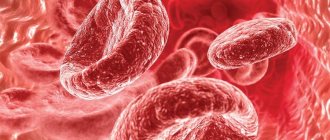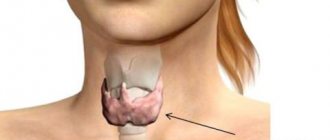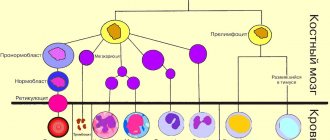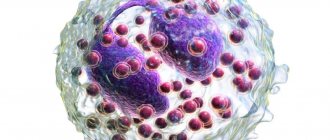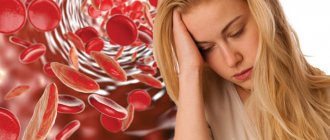Low phosphorus: causes and signs
Alcohol intake impairs phosphorus absorption
The development of hypophosphatemia is caused by insufficient levels of elements necessary for the absorption of P. For example, a deficiency in protein in the diet is accompanied by a decrease in the level of P in the blood. Constant consumption of alcohol provokes the development of chronic R deficiency. Microelement malabsorption occurs in various malabsorption syndromes.
Increased loss of P in the urine is the result of diseases of the endocrine system, when the synthesis of parathyroid hormone exceeds the physiological need. Another reason is excessive dosage of diuretics.
A decrease in P concentration in the blood is accompanied by a disturbance in the acid-base balance, when alkali compounds accumulate in the body. An excess of certain elements leads to the development of phosphorus deficiency, primarily calcium, as well as aluminum and magnesium.
Muscle weakness may be a sign of hypophosphatemia
The movement of P compounds from the extracellular space into cells occurs during intensive treatment of diabetic ketoacidosis, resumption of normal nutrition after prolonged malnutrition, recovery after removal of the parathyroid glands, and respiratory alkalosis.
Acute hypophosphatemia occurs with alcohol intoxication, extensive burns, increased ventilation of the lungs, and in the postoperative period.
A mild form of P deficiency usually does not manifest itself clinically; with a significant decrease in P concentration in the blood, muscle weakness, bone pain, and convulsions are felt. Symptoms of liver dysfunction, pathological fractures, softening and deformation of skeletal bones are observed.
- IS KNEE PAIN ONLY DUE TO CALCIUM LACK?
Danger
The causes and consequences of increased phosphorus in the blood are interrelated. A high content of this component leads to complications. If there is no appropriate treatment, this phenomenon can lead to:
- severe liver dysfunction - nausea and bitterness in the mouth;
- anemia with iron deficiency;
- vascular atherosclerosis;
- external and internal bleeding;
- bowel cancer.
With timely examination by a doctor and quality treatment, these consequences can be avoided. The reasons for increased phosphorus in the blood of a child and an adult are the same. The analysis is also performed according to the same rules.
Low content
Often, a decrease in phosphate in the blood occurs even with sufficient dietary intake. A reduced content of this mineral is considered dangerous. This phenomenon is associated with:
- metabolic disorders;
- dysfunction of the excretory system;
- various poisonings, including from harmful foods and drinks;
- dysfunction of the parathyroid gland.
Symptoms of P deficiency usually manifest as abnormalities in the muscular and nervous systems. Appears:
- muscle cramps, bone pain;
- changes in skin sensations;
- heart and lung failure;
- anxiety, irritability, apathy;
- loss of appetite.
With a prolonged lack of phosphorus, a dangerous disease appears - hypophosphatemia. Then it is likely that the symptoms will worsen and the following will appear:
- vomiting, diarrhea;
- bleeding gums, softening of bones, their fragility;
- abnormalities in the central nervous system;
- heart failure.
Normalization
How to restore the component level? In case of severe deviations, it is necessary to take medications prescribed by a doctor based on tests. In general, every person needs to consume foods rich in phosphorus. The mineral is better absorbed from plant foods. They are rich in bran, wheat sprouts, pumpkin and sunflower seeds, nuts, cashews, almonds, and yeast. Phosphorus is found in liver, eggs, cheese, red fish - trout, salmon, pink salmon.
It should be taken into account that a lot of phosphorus is present in sausages, carbonated drinks, and ice cream. If a person constantly eats such foods, there will be an excess of the mineral in large quantities. This is dangerous, so it is important to maintain a healthy and proper diet.
If an increase or decrease in phosphorus is associated with illnesses, then treatment of these diseases is required. Contact with phosphate fertilizers has a negative effect. If the level of this component changes, its use should be stopped.
Norm of phosphorus in blood
Phosphorus enters the body with food, because chemical elements cannot be produced in the body. In order for its absorption to proceed correctly, the presence of a sufficient amount of calcium and vitamin D is required. The absorption of this chemical element is significantly reduced by excessive levels of iron, magnesium and aluminum in the body. The accepted norm of phosphorus in the blood, depending on age, will be as follows:
- Children under 2 years of age – from 1.45 to 2.16 mmol/l.
- Children's age from 2 to 12 years – from 1.45 to 1.78 mmol/l.
- Age category from 12 to 60 years – from 0.87 to 1.45 mmol/l.
After crossing the age limit of 60 years, the normal value of phosphorus in the blood of women and men differs. For a woman, the norm is from 0.90 to 1.32 mmol/l. For men, the figure ranges from 0.74 to 1.2 mmol/l.
Submission of analysis
Diagnosis can be performed using a simple method, thanks to blood sampling. The analysis allows us to determine the content of inorganic phosphorus. It is measured throughout the day under the influence of certain factors, so to obtain accurate information you need to follow simple tips.
Blood is taken in the morning - from 8 to 11 o'clock, on an empty stomach. Food intake should be limited 8 hours before the tests; you should not have a large dinner before this, and also do not eat heavy, difficult-to-digest foods. You just need to drink plain water.
Blood is taken from a vein, and in small children it is taken from the heel. The test must be performed by a doctor. It is possible to perform a blood test for other indicators to get a clear picture.
Increased performance
An increased level of phosphate in the blood serum ( more than 1.45 mmol/l ) is called hyperphosphatemia.
This means that they begin to accumulate in various organs, in particular bone tissue, and this in turn begins to disrupt the functioning of the kidneys, heart or nervous system, and even episodes of seizures may appear.
- Blood cholesterol levels - table by age. Cholesterol in the blood - norms for women, men and children
Causes
- renal failure, which leads to incomplete removal of phosphates from the body;
- hypoparathyroidism (decreased function of the parathyroid gland);
- anemia;
- development of various tumors;
- destruction of muscle cells or healing of bones during fractures;
- osteoporosis;
- excess vitamin D;
- abnormalities in the functioning of the heart muscle;
- regular contact with this connection. Gardeners and people working in the agricultural industry, who often use phosphate fertilizers in their work, or military personnel who constantly use hazardous substances in combat, expose themselves to danger and are at risk.
Let's consider the reasons for the condition when phosphorus in the blood is elevated. So, what does this mean and what are the main reasons if there is an increased level of inorganic phosphorus in a child or adult:
- lack of calcium;
- renal dysfunction;
- intestinal insufficiency.
Main symptoms
- painful sensations in the joints;
- brittle bones;
- kidney stone disease;
- reduced iron levels (anemia);
- fatigue and fatigue;
- body aches;
- decreased level of leukocytes in the blood.
Important! The presence of these symptoms means you need to immediately visit a doctor.
Functions
Phosphorus is a chemical component that has properties similar to semimetals. It is able to interact with other substances in the body. Phosphorus can act as an oxidizing agent and as a reducing agent. With its help, the proper functioning of the entire body is ensured, optimal metabolism and balance of all systems and internal processes are maintained.
This component is especially abundant in the brain, muscles, teeth and bones. There is inorganic phosphorus in the blood. If it is not there, then a person cannot move, think, or breathe freely. The functions of the component include:
- formation of healthy teeth and bone tissue;
- full functioning of the heart and kidneys;
- transmission of nerve impulses, which is important for the nervous system;
- participation in growth, cell division, storage and reproduction of genetic information;
- participation in muscle function;
- influence on the accumulation and release of energy from cells;
- release of glucose from products through oxidation in chemical reactions;
- a necessity for strong physical, mental and psycho-emotional activity.
Interference:
- Anabolic steroids, androgens, beta-blockers (eg, acebutol, pindolol), estrogens, ergocalciferol, furosemide, growth hormone, hydrochlorothiazide, methicillin (for nephrotoxicity), phosphates, sodium etidronate, tetracycline (for nephrotoxicity).
- Acetazolamide, albuterol, aluminum-containing antacids, amino acids, anesthetics, calcitonin, carbamazepine, adrenaline, estramustine, fructose, glucocorticoids, glucose, hydrochlorothiazide (long-term use), phosphamide, insulin, isoniazid, oral contraceptives, phenytoin, sucralfate.
In cats
In animals, exceeding the norm of components also leads to various ailments. Increased phosphorus in the blood of a cat - what does this mean? The norm in these animals is 1-2.3 mmol/l, and its increase will be an excess. Increased phosphorus in the blood of a cat leads to chronic renal failure, nephrosclerosis, hydronephrosis, tuberculosis, polycystic disease, and kidney tumors. But a reduced level is also possible, which is a symptom of rickets.
Phosphorus is considered an important element. Its excess or deficiency causes adverse consequences that lead to changes in the functioning of various organs. Often illnesses lead to deviations from the norm, therefore, for various disorders, a comprehensive examination and identification of the root cause is required. In order for the level of the component in the body to be in the required quantity, you should consume more plant foods and eliminate harmful chemically produced foods.
What does alkaline phosphatase show?
The content of the article
Many biochemical processes occur in the human body, including the dephosphorylation reaction. In this case, phosphoric acid is separated from organic ester compounds, participating in calcium-phosphorus metabolism. This process occurs in the presence of the enzyme alkaline phosphatase.
Alkaline phosphatase is an enzyme found in many tissues of the body. But it is mainly concentrated in liver cells, bones, and placenta. The main volume is in the intestinal mucosa.
Alkaline phosphatase is represented in the body by 11 isoenzymes. To determine the cause of elevated alkaline phosphatase, it is also necessary to determine its tissue-specific isoenzymes:
- α2 – liver fraction;
- β1 – bone fraction;
- β2 – intestinal fraction.
Alkaline phosphatase is produced by the upper layer of the intestinal mucosa, but only participates secondarily in the digestive processes. The main function of alkaline phosphatase is dephosphorylation, that is, the separation of phosphoric acid from phosphorus-containing compounds. This enzyme also helps transport phosphorus throughout the body.
The enzyme is called "alkaline" because it is most active in an alkaline environment with a pH ranging from 8.6 to 10.1.
Alkaline phosphatase levels reflect the metabolic efficiency of phosphorus and calcium in the body.
Interpretation:
- Renal failure, hypoparathyroidism, pseudohypoparathyroidism, respiratory acidosis, acromegaly, diabetes mellitus, osteolytic metastatic bone tumors, myelogenous leukemia, sarcoidosis, vitamin D toxicity, fracture healing, portal cirrhosis, pulmonary embolism
- Decreased intestinal absorption, alcohol abuse, respiratory alkalosis, osteomalacia, steatorrhea, renal tubular acidosis, growth hormone deficiency, gram-negative bacterial septicemia, hypokalemia, familial hypophosphatemic rickets.
Sample result (PDF)
Treatment
Therapy is determined by the pathology of the organs, in which a change in the concentration of the component in the serum is observed. During an exacerbation, emergency therapy is required, for example, hemodialysis for tumor collapse syndrome.
If endocrine disorders are detected, then hormonal correction is needed. In case of renal failure, the mainstay of treatment is to reduce dietary phosphorus intake. These patients require a low-protein diet and phosphate binders. End-stage kidney disease requires calcium carbonate.
A dialysis patient is prescribed Sevelamer. The drug binds phosphates in the digestive tract, lowering their concentration in the blood serum. Treatment of hyperphosphatemia is carried out under the supervision of a doctor, as self-medication can lead to a worsening of the condition.
